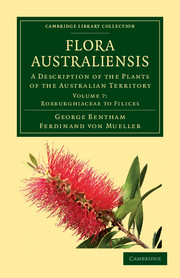188 results
Contents
-
- Book:
- Flora Australiensis
- Published online:
- 05 May 2012
- Print publication:
- 08 December 2011, pp ix-x
- First published in:
- 1878
-
- Chapter
- Export citation
Order CXXVI - Roxburghiaceæ
-
- Book:
- Flora Australiensis
- Published online:
- 05 May 2012
- Print publication:
- 08 December 2011, pp 1-2
- First published in:
- 1878
-
- Chapter
- Export citation
Order CXXIX - Philydraceæ
-
- Book:
- Flora Australiensis
- Published online:
- 05 May 2012
- Print publication:
- 08 December 2011, pp 73-75
- First published in:
- 1878
-
- Chapter
- Export citation
Order CXLVI - Marsileaceæ
-
- Book:
- Flora Australiensis
- Published online:
- 05 May 2012
- Print publication:
- 08 December 2011, pp 682-684
- First published in:
- 1878
-
- Chapter
- Export citation
Order CXXXVI - Typhaceæ
-
- Book:
- Flora Australiensis
- Published online:
- 05 May 2012
- Print publication:
- 08 December 2011, pp 158-161
- First published in:
- 1878
-
- Chapter
- Export citation
Order CXXXII - Juncaceæ
-
- Book:
- Flora Australiensis
- Published online:
- 05 May 2012
- Print publication:
- 08 December 2011, pp 92-132
- First published in:
- 1878
-
- Chapter
- Export citation
CONCLUDING PREFACE
-
- Book:
- Flora Australiensis
- Published online:
- 05 May 2012
- Print publication:
- 08 December 2011, pp v-viii
- First published in:
- 1878
-
- Chapter
- Export citation
Order CXXXVII - Lemnaceæ
-
- Book:
- Flora Australiensis
- Published online:
- 05 May 2012
- Print publication:
- 08 December 2011, pp 161-164
- First published in:
- 1878
-
- Chapter
- Export citation
Order CXL - Eriocauleæ
-
- Book:
- Flora Australiensis
- Published online:
- 05 May 2012
- Print publication:
- 08 December 2011, pp 189-198
- First published in:
- 1878
-
- Chapter
- Export citation
ERRATA
-
- Book:
- Flora Australiensis
- Published online:
- 05 May 2012
- Print publication:
- 08 December 2011, pp 782-782
- First published in:
- 1878
-
- Chapter
- Export citation
Order CXLI - Centrolepideæ
-
- Book:
- Flora Australiensis
- Published online:
- 05 May 2012
- Print publication:
- 08 December 2011, pp 198-208
- First published in:
- 1878
-
- Chapter
- Export citation
Order CXXXIII - Palmæ
-
- Book:
- Flora Australiensis
- Published online:
- 05 May 2012
- Print publication:
- 08 December 2011, pp 132-147
- First published in:
- 1878
-
- Chapter
- Export citation
CONSPECTUS OF THE ORDERS
-
- Book:
- Flora Australiensis
- Published online:
- 05 May 2012
- Print publication:
- 08 December 2011, pp xi-xii
- First published in:
- 1878
-
- Chapter
- Export citation
Order CXLII - Restiaceæ
-
- Book:
- Flora Australiensis
- Published online:
- 05 May 2012
- Print publication:
- 08 December 2011, pp 208-246
- First published in:
- 1878
-
- Chapter
- Export citation
Order CXXXI - Commelynaceæ
-
- Book:
- Flora Australiensis
- Published online:
- 05 May 2012
- Print publication:
- 08 December 2011, pp 81-92
- First published in:
- 1878
-
- Chapter
- Export citation

Flora Australiensis
- A Description of the Plants of the Australian Territory
-
- Published online:
- 05 May 2012
- Print publication:
- 08 December 2011
- First published in:
- 1878
Order CXLIII - Cyperaceæ
-
- Book:
- Flora Australiensis
- Published online:
- 05 May 2012
- Print publication:
- 08 December 2011, pp 246-449
- First published in:
- 1878
-
- Chapter
- Export citation
Order CXXX - Xyrideæ
-
- Book:
- Flora Australiensis
- Published online:
- 05 May 2012
- Print publication:
- 08 December 2011, pp 75-81
- First published in:
- 1878
-
- Chapter
- Export citation
Order CXXVII - Liliaceæ
-
- Book:
- Flora Australiensis
- Published online:
- 05 May 2012
- Print publication:
- 08 December 2011, pp 2-71
- First published in:
- 1878
-
- Chapter
- Export citation
INDEX OF GENERA AND SPECIES
-
- Book:
- Flora Australiensis
- Published online:
- 05 May 2012
- Print publication:
- 08 December 2011, pp 783-806
- First published in:
- 1878
-
- Chapter
- Export citation



